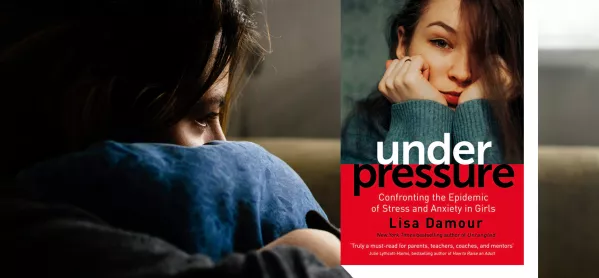
- Home
- Book review: Under Pressure
Book review: Under Pressure

Under Pressure
Author: Lisa Damour
Publisher: Atlantic Books
Details: £14.99; 288 pages
ISBN: 9781786493965
Dr Lisa Damour is a psychologist specialising in female adolescence, and is also the executive director of the Laurel Centre for Research on Girls, in Ohio. Her first book, Untangled, explored the changes that girls go through as they move towards womanhood. Her latest, Under Pressure, explores the idea that stress and anxiety in girls, while on the rise, is part of teenage life and can be used to teach girls to “bounce back”.
The book is solution-focused and primarily reflects upon the difference between stress and anxiety and between healthy and unhealthy stress within all of the key parts of teenage life, such as at school, in relationships and at home. Through research and anecdotes from her patients, Damour engages the reader and offers practical strategies to address the rise in teenage anxiety.
The book is an easy read, with short chapters and sub-headings, and can be read in small, bite-sized bursts. I found myself re-reading some sections to try to memorise some of the analogies I recognised from my own experience as a senior leader in a girls’ school.
Healthy part of life
Damour says that “somewhere along the line we got the idea that emotional discomfort is always a bad thing”. On the contrary, she says, acceptance that fear and anxiety can be a healthy part of life, if framed effectively, is the only way to overcome what she feels is an epidemic in schools.
Of course, we already know that girls face enormous pressure to succeed and that they have a tendency to turn this pressure inwards. But the author is adept at using examples from her own experiences with patients to suggest that we can rethink this and use it to build resilience in young women. Damour recommends a change of narrative, away from attempts to avoid or “cure” stress and anxiety, towards a notion that we can harness these to empower girls. This is a different message from many other texts that discuss teenage anxiety and try to find ways to avoid rather than embrace it.
This is not just pop psychology, but is wholly grounded in detailed experience and knowledge that has been gained in a centre where female teen years are investigated and researched. While other psychological texts can be theory-heavy, much of this book’s content is expressed in metaphors or analogies that are instantly recognisable and allow the reader to visualise what is being discussed, and to reframe anxiety. Here is one such analogy: “We should think about stress the way Goldilocks thought about making herself comfortable while trespassing. We don’t want [stress levels] to be too low or too high. But we can embrace reasonable levels of stress as a nutrient for healthy development that helps [a girl] to grow into the strong and durable young woman we want her to be.”
Being imperfect
Additionally, the idea that girls need to be given further opportunity to be imperfect is one element of the book that will have a direct impact on my parenting and on my teaching practice. Damour highlights the ever-increasing pressure on girls to succeed on many different levels, from academic attainment through to physical appearance and to their various different relationships. Each of these areas is addressed in a separate chapter of the book, and the section on school is particularly useful for educationalists.
There is much encouragement to allow girls to take risks, without the fear of making mistakes: to give them freedom to explore what they are capable of and to go beyond their comfort zone, so that failure is both possible and welcomed, and is learned from.
When teaching girls, it is noticeable that they want to please, to achieve and to be praised. Damour suggests that letting them make mistakes, learn from them and develop ways to mentally get past them is the key to raising and nurturing teenage girls. This could be supported in schools through both low-stakes testing and tasks in lessons, where making mistakes is inevitable, or by providing adventurous co-curricular activities (such as a difficult hike or high-ropes course), where there is a risk of both failure and initial fear. The power of overcoming failure, so that it is no longer feared, is critical to girls’ mental wellbeing.
I really cannot recommend this book highly enough as a parent and a teacher. It was easy to understand, totally kept me hooked and has already been passed around to several friends and work colleagues who have found it equally enlightening. There can be no doubt that anxiety and stress among the teenagers we teach is ever-increasing, but perhaps, by rethinking the impact of these emotions, we can address it in a different way and stem the tide.
Beth Dawson is deputy head at Sutton High School, part of the Girls’ Day School Trust. She tweets @SuttonhighDH
Register with Tes and you can read five free articles every month, plus you'll have access to our range of award-winning newsletters.
Keep reading for just £4.90 per month
You've reached your limit of free articles this month. Subscribe for £4.90 per month for three months and get:
- Unlimited access to all Tes magazine content
- Exclusive subscriber-only stories
- Award-winning email newsletters
You've reached your limit of free articles this month. Subscribe for £4.90 per month for three months and get:
- Unlimited access to all Tes magazine content
- Exclusive subscriber-only stories
- Award-winning email newsletters
